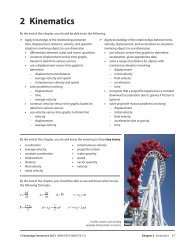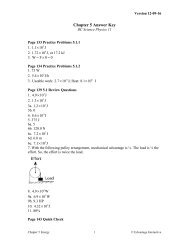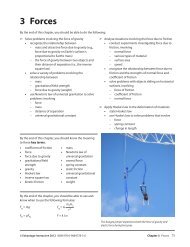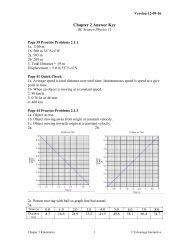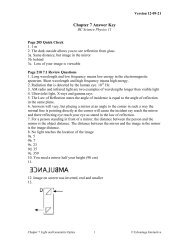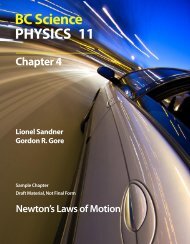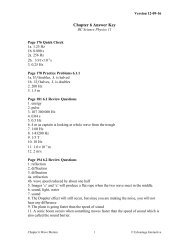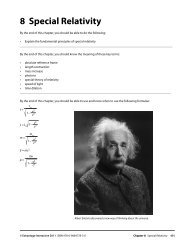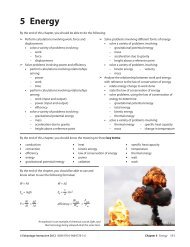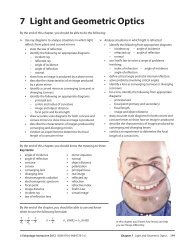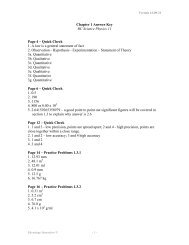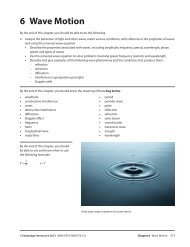4 Newton's Laws of Motion - BC Science Physics 11
4 Newton's Laws of Motion - BC Science Physics 11
4 Newton's Laws of Motion - BC Science Physics 11
Create successful ePaper yourself
Turn your PDF publications into a flip-book with our unique Google optimized e-Paper software.
Ideal Conditions<br />
Quick Check<br />
Newton’s first law <strong>of</strong> motion incorporated Galileo’s law <strong>of</strong> inertia. The first law <strong>of</strong><br />
motion, or law <strong>of</strong> inertia, can be stated this way:<br />
A body will continue to move at the same speed and in the same direction for as<br />
long as there are no unbalanced forces acting on it.<br />
Put another way, an object wants to keep doing what it is already doing. This means if a<br />
basketball is placed on the floor, it will not move until another force acts on it. Someone<br />
picking up the ball is an example <strong>of</strong> a force acting on the ball.<br />
Sometimes it appears that Newton’s first law does not apply. For example, when<br />
coasting on your bicycle along a flat part <strong>of</strong> the road, you have probably noticed that you<br />
slow down even though it appears no forces are acting on the bicycle. In fact, the force<br />
<strong>of</strong> friction between the road and tires is responsible for slowing the bicycle. If there were<br />
no friction, the bicycle would continue at the same speed until another force acted on<br />
it. That is why in many physics problems about motion, you will see the assumption that<br />
there is no friction. A situation that is assumed to have no friction is called ideal conditions.<br />
Using ideal conditions, we can focus on the motion being observed. By specifying ideal<br />
conditions, we also show we know that friction would have to be considered under<br />
normal conditions.<br />
1. A car you are driving in encounters a patch <strong>of</strong> ice just as the car enters a corner turn. Using your knowledge<br />
<strong>of</strong> Newton’s first law <strong>of</strong> motion, explain what will happen to the car.<br />
2. You are a judge listening to an injury claim from a bus passenger. The passenger claims to have been hurt<br />
when the bus driver slammed on the brakes and a suitcase came flying from the front <strong>of</strong> the bus to hit the<br />
passenger. Do you believe the passenger’s description <strong>of</strong> what happened? Explain your answer.<br />
3. When you receive a drink for a take out order, usually there is a lid on the cup. Use Newton’s first law to<br />
explain why the lid is necessary to prevent spills.<br />
104 Chapter 4 Newton’s <strong>Laws</strong> <strong>of</strong> <strong>Motion</strong> © Edvantage Interactive 2012 ISBN 978-0-9864778-3-6



